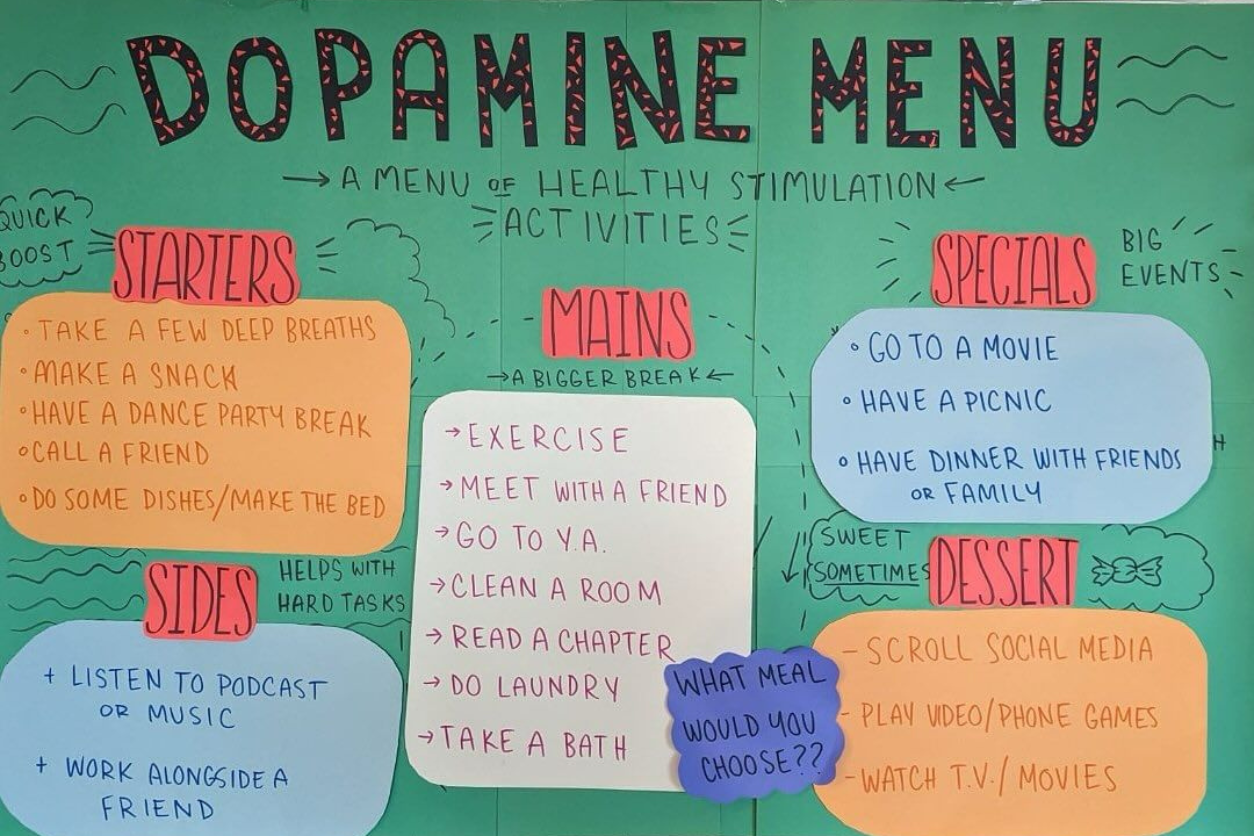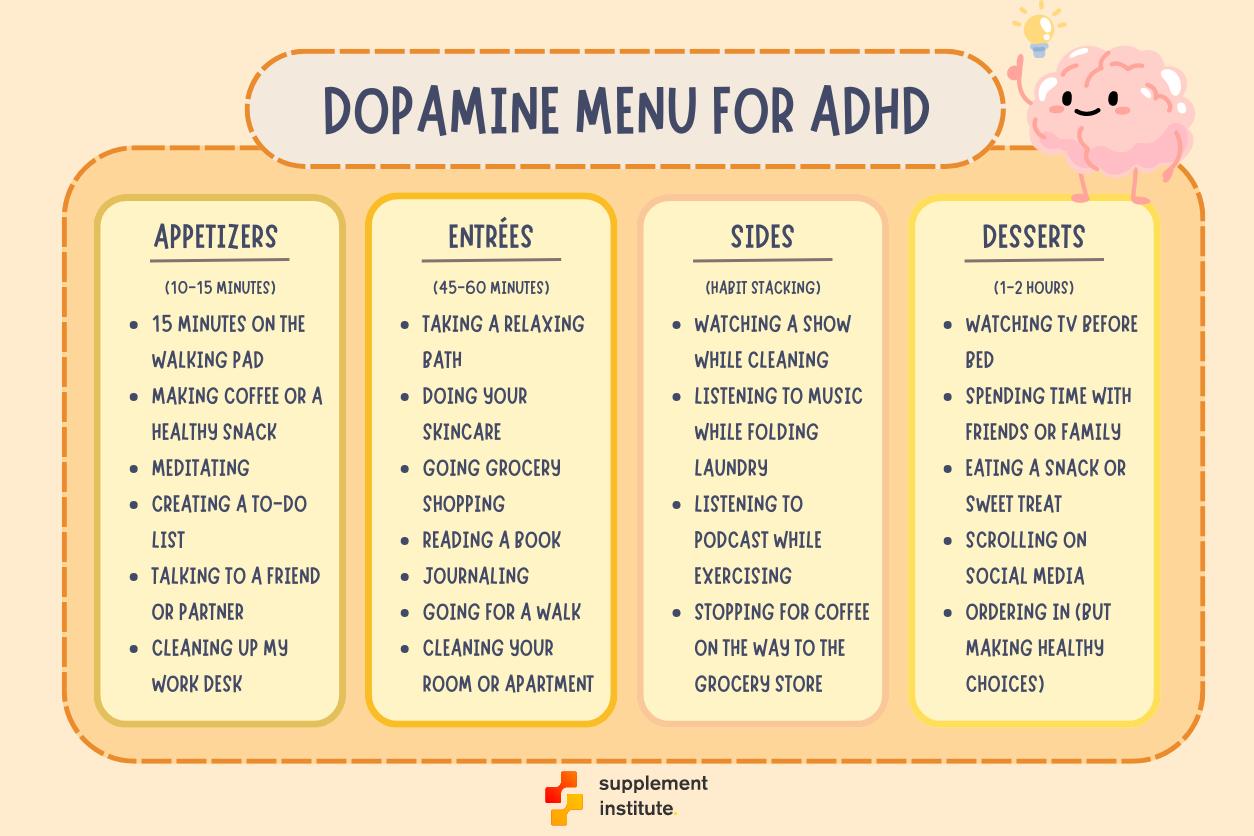Dopamine Menu: How the TikTok Trend Helped Me Manage ADHD and Bulimia Recovery

Image credit: @coastmentalhealth (Instagram)
If you’ve ever been caught in the endless loop of scrolling, snacking, and searching for motivation, I’m right there with you. Living with ADHD means I’m constantly fighting to stay focused, and when you throw eating disorder (ED) recovery into the mix, well, let’s just say my brain doesn’t always play fair. Like so many others, I found myself endlessly searching for ways to take back control. Then I stumbled on TikTok’s viral “dopamine menu” trend, and honestly, it has made a bigger impact on my journey than I expected.
The dopamine menu is pretty straightforward—create a personal list of activities that boost dopamine in a healthy way. It sounds simple, but if you have ADHD like me, structure can sometimes feel like a lifeline. I’ve often found myself seeking dopamine in less-than-ideal places: binge-watching TV, endlessly scrolling through social media or turning to food for comfort. The problem is, while these activities give you that immediate hit, they often leave you feeling worse afterward. So, I decided to give this dopamine menu a try and here’s how it went.
What Is Dopamine and Why Is It So Important?
Before I get into how the dopamine menu worked for me, let’s talk about dopamine itself. This little neurotransmitter plays a huge role in how we feel motivated and rewarded. Dopamine is a neurotransmitter that plays a key role in how we feel pleasure, stay motivated, and focus on tasks. It’s often called the “reward chemical” because it reinforces behaviors by making us feel good when we complete something, like finishing a project or even eating a meal. The brain likes to reward us, encouraging us to repeat behaviors that produce dopamine.
For those with ADHD, the problem is that there’s usually a dopamine deficiency. That lack of dopamine can make it feel almost impossible to do everyday tasks like cleaning, working, or even brushing your teeth. This leads to a vicious cycle of craving dopamine from quick, often unhealthy sources like junk food or endless social media scrolling. But the reality is that these short-term fixes only provide temporary satisfaction, leaving us drained and often overwhelmed afterward.
How Dopamine Menu Helped My ADHD and ED Recovery
I’ve always struggled with impulsive behaviors, especially when my dopamine levels were low. And when you’re going through ED recovery, that impulsiveness can spill into your eating habits. I knew I needed healthier ways to manage my cravings—both physical and emotional. Dopamine menu gave me a structured way to look at the things that could boost my dopamine in a more sustainable way, without sending me into a spiral of regret or exhaustion.
When I first tried it, I thought the concept seemed almost too simple. But when you’re struggling to balance ADHD and recovery, simple can be powerful. Instead of instinctively reaching for my phone or indulging in old habits, I had a list of activities ready to go. And not just any activities but ones that were tailored to how much time I had and what I needed at the moment. It helped me feel more in control of my actions, even when my brain felt like it was fighting against me.
Creating My Own Dopamine Menu
The process of making my dopamine menu was eye-opening. I broke it down into “appetizers,” “entrées,” and “desserts” based on how much time I had and how much dopamine I needed.

Appetizers (5 to 20 Minutes)
These are activities that take around five to twenty minutes and give you a quick dopamine hit without sucking you into a vortex of time-wasting. Maybe you only have a few minutes between meetings, or you’re trying to break up the monotony of a long workday. Quick dopamine boosters can be a short walk or organizing a small part of your space. These are small actions that get your brain moving and provide an immediate sense of accomplishment.
My appetizers were quick dopamine hits—things like stretching for five minutes or making a to-do list. These gave me that instant sense of accomplishment without the guilt I often felt after scrolling through TikTok or indulging in impulsive behaviors.
Entrées (45 to 60 Minutes)
When you’ve got more time on your hands, say about 45 minutes to an hour, it’s time to dig into some more fulfilling dopamine boosters. These activities are a bit more involved and can help you get into a flow state. For someone with ADHD, these activities might include going to the gym, cooking a meal from scratch, or diving into a creative project like painting or writing.
The beauty of these longer activities is that they not only boost dopamine but also help with focus and productivity. You might even find that after engaging in one of these activities, you’re able to tackle other tasks with more energy and motivation. For me, this included things like going for a walk, cooking a healthy meal, or working on a creative project. These were especially helpful when I felt stuck in a rut—like when recovery was hard or if I found myself procrastinating too much. Knowing I had these activities as a backup made a huge difference in how I approached my day.
Sides (Habit Stacking)
The side section of your dopamine menu is all about pairing your main activities with something that makes them more enjoyable. For someone like me who has ADHD and struggles with boredom or anxiety, this can make tackling tasks so much more interesting. For instance, if cleaning your apartment feels like a chore, pair it with a podcast you love or put on a playlist that makes you want to move. By adding these little dopamine hits to otherwise mundane tasks, you’re more likely to get them done without feeling drained.
Maybe you always avoid going grocery shopping because it feels like a hassle. Pair it with a treat, like grabbing a coffee on your way, and suddenly, the task feels less daunting. These little rewards make even the most tedious tasks a bit more fun and bearable.
Desserts (30 to 60 Minutes)
We all need indulgence now and that’s what the dessert section of the dopamine menu is all about. These are your ‘happy’ treats—activities that you genuinely enjoy but should consume in moderation. It could be watching your favorite TV show, scrolling through social media, or indulging in a dessert or a snack you’ve been craving. The key here is to limit these activities so they don’t become your go-to dopamine source, which can lead to burnout or even addiction.
Spending an hour scrolling Instagram every night might seem harmless, but when it starts taking away from other important activities, it becomes detrimental. Instead, treat yourself to these activities mindfully, in small doses, and enjoy them for what they are—occasional treats, not everyday habits. I used my desserts section to remind myself that moderation is key. Watching an episode of my favorite show or treating myself to something sweet was fine as long as I didn’t let it become the default way I sought dopamine.
The Impact on My Recovery
One of the biggest surprises for me was how much the dopamine menu helped in my ED recovery. In the past, I’d often turn to food for comfort or as a way to distract myself when things felt overwhelming. The dopamine menu gave me healthier alternatives that didn’t just satisfy a craving—they helped me process what I was feeling. Whether it was doing a quick mindfulness exercise or spending time journaling, I found that these small activities helped me tune into my emotions instead of trying to escape them.
Recovery isn’t linear, and there are still days when I struggle. But having this menu as a tool has helped me build healthier habits, both in managing my ADHD and my relationship with food. It’s given me a framework to lean on when my brain feels scattered, and it’s helped me feel more in control of the choices I make each day.
Why It Works
I think what makes the dopamine menu so effective, especially for people like me with ADHD, is that it provides structure in moments where you feel scattered. It’s not just about having options—it’s about having the right options when you need them. Instead of relying on impulsive decisions that lead to regret, the dopamine menu offers healthier, more sustainable ways to get that sense of reward.
For me, this was crucial in my recovery from bulimia. I needed to find ways to manage my dopamine that didn’t involve food or other quick fixes. The dopamine menu gave me that structure and energy, and it reminded me that it’s okay to take small steps toward feeling better, whether that’s taking five minutes to breathe or spending an hour doing something creative.
One of the most notable benefits I experienced from the dopamine menu was improved sleep quality. Mental stimulation can significantly enhance sleep, and good sleep is essential for regulating dopamine levels.
Related: What Is Dopamine Detox and Does It Actually Work?
Final Thoughts
Living with ADHD and going through ED recovery can feel like an uphill battle, but tools like the dopamine menu can make a real difference. It’s not about perfection—it’s about having a roadmap that helps guide you toward healthier choices. For me, the dopamine menu has been a way to take back control over how I seek pleasure and motivation in my life. And while I’m still on this journey, having this simple yet powerful tool has made all the difference in how I approach each day.
If you’re struggling with ADHD or just trying to break out of unhealthy habits, I’d recommend giving the dopamine menu a try. It’s not a magic fix, but it’s definitely a step in the right direction.
Building a Stronger You
Supplement Institute is the fruit of extensive online publishing experience, spanning the breadth of SEO strategies to the nuances of paid advertisements. Our journey, marked by significant achievements and learning moments, inspires our core mission: to empower our readers with an abundance of information. By sharing insights and key learnings, we aim to provide you with the knowledge needed to navigate the complex world of supplements, helping you make well-informed decisions for your health and well-being. Welcome to Supplement Institute, where information is your greatest supplement.